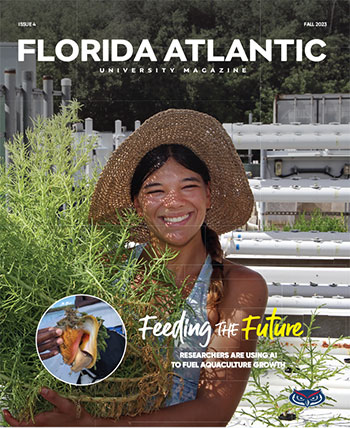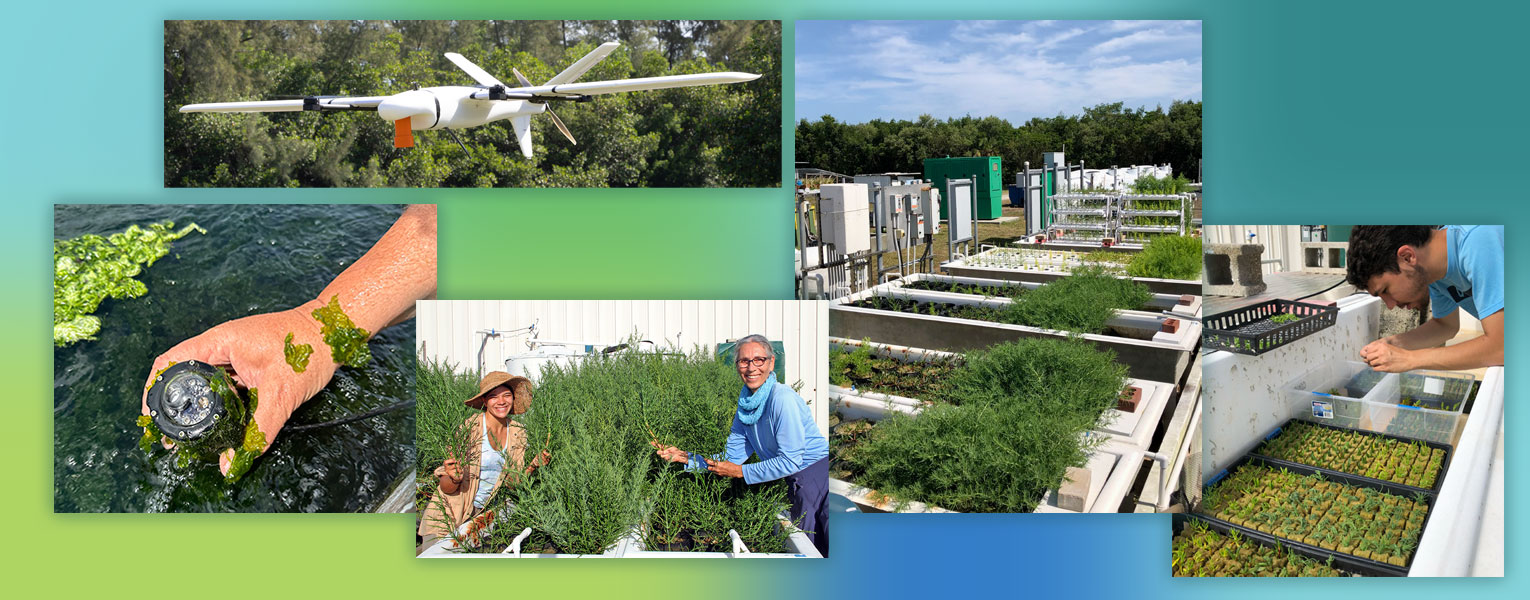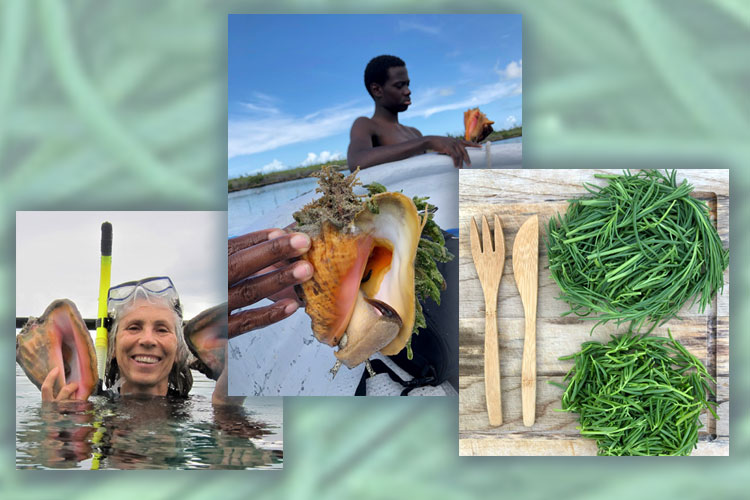Florida Atlantic: Farms of the Future
Using AI to Meet the Global Need for Sustainable Seafood
By Chelsey Matheson
As the global human population continues to swell, food production must stretch to meet our growing needs. The world’s oceans are particularly stressed, as fisheries wither under the constant demand for more seafood.
Studies of primary nutrient sources show that the ocean reached its maximum productivity for generating wild-caught seafood in the late 1980s. As a result, more than 50 percent of the seafood consumed in the U.S. comes from aquaculture, but less than 1 percent is produced domestically. From tapping ancient food sources to creating cutting-edge tools, researchers at FAU Harbor Branch Oceanographic Institute are working to change that, by developing new aquaculture techniques to meet the growing global demand for sustainable seafood.
FAU Harbor Branch’s aquaculture research initiative involves a team of scientists and engineers working to increase the supply of nutritious, safe and high-quality domestic seafood; improving production efficiency; increasing seed stock availability; developing novel feeds; improving aquatic animal health; creating a skilled labor force; and enhancing technology transfer to the private sector.
“If we’re going to continue to increase the demand for seafood, the gap in productive potential by wild-caught fisheries needs to be filled, and fundamentally, we know it’s not going to come from the oceans. It’s got to come from aquaculture,” said Paul S. Wills, Ph.D., research professor and associate director for research at Harbor Branch and principal investigator of the integrated multi-trophic aquaculture (IMTA) system project. “This is why we’re seeing the movement from huntergatherer to farming with our seafood products.”
AI to Improve Efficiency
Monitoring is a major challenge for aquaculture farmers, particularly in pond aquaculture, as dissolved oxygen management is crucial to preventing fish kills. Traditional dissolved oxygen monitoring practices are time-consuming, expensive, imprecise and labor intensive, which is particularly detrimental as the industry buckles under a prolonged labor shortage.
Florida Atlantic scientists and engineers are working directly with aquaculture farmers to develop cutting-edge technology to improve efficiency and productivity through autonomous monitoring. A team led by Bing Ouyang, Ph.D., associate research professor in ocean engineering and technology at FAU Harbor Branch, has taken monitoring to the skies through a Hybrid Aerial Underwater RobotiC System (HAUCS). The team includes Wills; Jason Hallstrom, Ph.D., director of FAU’s Institute for Sensing and Embedded Network Systems Engineering; and Tsung-Chow Su, Eng.Sc.D., professor in the Department of Ocean and Mechanical Engineering. The project is supported by a $1.2 million grant from the United States Department of Agriculture’s National Institute of Food and Agriculture in collaboration with the National Science Foundation’s National Robotics Initiative 2.0.
Cooperation with the fish farm community has been essential during the development stage of the HAUCS project. The project originated from Peter Reiff, owner of Logan Hollow Fish Farm in Illinois. Ouyang and Wills spent extensive research time at the farm during the project’s first phase. Testing also was conducted at Flowers Fish Farm in Dexter, Missouri; Aqua Blue Cichlids in Fellsmere; and at Southern Illinois University’s Touch of Nature aquaculture research farm, as well as at its Center for Fisheries, Aquaculture and Aquatic Sciences.
Currently, pond aquaculture farmers rely on technicians to drive around the farm to collect data and make decisions on the health of the ponds based on limited information. One innovative sensing solution in HAUCS is to adopt drones equipped with underwater sensors that can deploy automatically and expedite these surveys while also producing more comprehensive data.
The process works by landing a drone on a pond’s surface and dropping an underwater sensor payload into the pond, which instantly scans conditions through the entire water column. Graduate students working with Ouyang and Wills helped develop the system.
“One of the challenges of aquaculture ponds is that there is a vertical stratification of dissolved oxygen,” Ouyang said. “So, the dissolved oxygen is normal or high on the top layer, but it could become critically low at the bottom layer. Normally, the people doing the survey don’t have that information. Our system can provide that information, so resting on the water really breaks through in that regard.”
In addition to dissolved oxygen, HAUCS collects a large swath of data including wind, solar radiation and air temperature, and sends the information to a centralized database that feeds a machine learning algorithm. The resulting artificially intelligent model can then make predictions about pond conditions and assess potential risks, which translates to more efficient use of resources and an overall healthier fish farm.
“We measure as many data points as we can because in nature, all of these things have some effect on pond dynamics,” Wills said.
In essence, HAUCS is an “Internet of Things” solution dedicated to the operation of pond aquaculture farms. Until now, the focus of the HAUCS project has been developing automated monitoring and prediction technologies and creating an interface where farmers can quickly access the real-time information. The next step is automated action. This project is in the development stage, but Ouyang’s team envisions incorporating ground-based AI-empowered machines to work in tandem with HAUCS mobile sensing systems to perform essential, but traditionally labor-intensive, tasks based on a robust machine-learning prediction model. For instance, if HAUCS senses a problem with a pond’s dissolved oxygen level, it would be able to automatically deploy an emergency aerator to stabilize the situation.
“We want to work toward an AI-driven intelligent fish farm of the future,” Ouyang said. “That’s our end-goal here.”
As a first step, the team recently built a vertical take-off and landing (VTOL) plane, compliant with the National Defense Acquisition Act.
“To support the more sophisticated AI model to be developed in the next phase, we will need to collect a lot more data about the farm,” Ouyang said. “The geometry of the pond, the general environment of the pond, weather, surface color, and all of that information. That’s why we want this VTOL plane to complement the quadcopter drone we already use.”
The VTOL plane also has longer endurance than the quadcopter HAUCS drones, so it has potential to be adapted to other environmental monitoring applications, such as coastal zone surveillance or environmental assessments of marine renewable energy sites.
Multi-trophic Aquaculture
Aquaculture studies at FAU Harbor Branch also look at novel approaches to the type of food being produced, as well as developing technology to improve production capacity and efficiency while minimizing waste. The IMTA system, a sophisticated, land-based recirculating system, is central to this effort, as it provides a stable environment for scientists to conduct their research.
The IMTA system supports cultivation of animal, plant and algae species that exist at different levels of the natural food chain using a complex, highly controlled water flow. Organisms are situated within the system so that waste is engineered into resources, as each species draws its energy from nutrients provided by other occupants. Species that have been grown in the system include pompano, cobia, red drum, shrimp, sea urchins, sea cucumbers, conch, oysters, clams and sponges.
Salty Superfoods
Though finfish and shellfish are the most well-known aquaculture products, plant crops also are incorporated into the IMTA system. These crops contribute to the health and efficiency of the system by absorbing nutrients produced by finfish, thereby cleaning the water as it circulates to other parts of the system. The outdoor tanks where plants are grown also collect rainfall, helping to naturally replenish the system’s water supply. Importantly, the plants offer great potential to be a profitable aquaculture product.
Sea vegetables are superfoods that grow quickly, require little or no fresh water, and offer higher concentrations of minerals and antioxidants. Researchers at FAU Harbor Branch are studying cultivation and harvesting methods of these mighty greens to make them a sustainable, valuable food crop.
Among the sea vegetables grown are a group called halophytes, salt-loving land plants that have adapted to growing in salt water. They are found along coastlines and in salt marshes across the globe, and edible halophytes have been consumed by humans for centuries.
One of the ways that halophytes have adapted to growing in saltwater is by accumulating salt within their cells through ion compartmentalization in the vacuoles. The result of this process is a succulent, salty, cucumber-textured vegetable that is packed with essential minerals like potassium, calcium, manganese, zinc, iron and sodium.
“Halophytes are amazing plants because you don’t need fresh water, which is a big deal because there is so little fresh water in the world,” said Megan Davis, Ph.D., principal investigator and research professor at FAU Harbor Branch. “They are very sustainable and can be planted just about anywhere there is access to saltwater.”
Four species of edible halophytes have been studied at FAU Harbor Branch: sea asparagus (Salicornia bigelovii), sea purslane (Sesuvium portulacastrum), saltwort (Batis maritima) and sea blite (Suaeda linearis). All these species are native to Florida and can be found growing in the wild near the Harbor Branch campus in Fort Pierce.
Studies show that sea vegetables thrive in cultivation, whether they are planted with their roots submerged in a substrate — such as sand or clay pebbles — or in a floating raft system with their roots directly submerged in saltwater. Sea vegetables can grow year-round, but the prime growing season is during the cooler fall and winter months in central and south Florida.
The most recent sea vegetable study focused on determining the optimal harvest frequency for sea blite, observing both the harvestable yield and its nutritional content.
“We were looking to increase biomass and nutritional content. Those are the underlying drivers of our halophyte studies because we’re interested in providing an alternative vegetable that doesn’t require fresh water,” said Amanda Matthews, research and education coordinator for the sea vegetable and queen conch program at FAU Harbor Branch.
The plants were grown in a dune sand substrate and incorporated into the IMTA system, where they received saltwater rich in bionutrients from pompano and other animals being raised in different parts of the system. Results of the study showed that frequent harvests stunted the growth of the plants leading to less overall biomass, but more nutrients were available in the edible portions of these plants. Future studies are planned to further investigate the best schedule for harvesting without reducing overall productivity.
Davis said she sees big potential for halophytes, particularly sea blite, to become viable, profitable crops. “I think if you’re looking at a business, you’re looking at trying to find the fastest-growing species that has the most appeal to it,” Davis said. “Suaeda[sea blite] grows an enormous amount of biomass compared to the other sea vegetables in a faster amount of time. It also has a very nice flavor and is very versatile because it can be considered a vegetable, a garnish or an herb. I think the challenge is getting the product to market, so people understand it.”
Salt-loving Crops
Another sea vegetable cultivated in the IMTA system isUlva lactuca, commonly known as sea lettuce. Seaweeds similar to sea lettuce are often found in dishes such as seaweed salad or poke bowls. Like halophytes,Ulvais a salt-loving crop that grows quickly both in the wild and in culture.
A study is underway to develop an automated biomass sensor system to optimize sea lettuce harvesting. The best time to harvest it is during the fastest part of the growth curve when the crop can bounce back more quickly and not stunt future production. Researchers have developed a prototype sensor that measures the relative density of sea lettuce in the tank. As the plants grow, the density gets thicker. The intention is for the sensor to eventually be able to alert farmers of the exact moment to harvest the crop.
During the development stage, the main activity is gathering data. The sensors are constantly monitoring not only density in the tank, but also variables like sunlight, temperature and nutrients. When the sea lettuce is harvested, the total biomass FAU Harbor Branch grows four species of sea vegetables as part of the Integrated Multi-Tropic Aquaculture (IMTA) system. Clockwise from top left are sea blite, sea purslane, sea asparagus and saltwort. This project is funded by the Harbor Branch Foundation through sales of the Aquaculture specialty license plate. is weighed and reported back to the system. The idea is to use AI to develop a model that can make continual, autonomous assessments of the biomass in the tank to predict the exact time that the crop should be harvested. The data being collected by the sensors can be accessed at any time via an online portal, which allows aquaculture farmers to have an accurate, real-time view of the health of their crop.
“We’re looking at ways to create precision aquaculture by developing tools to help farmers make better decisions that will make their operations more sustainable and easier to operate,” Wills said.
Wills said that time is of the essence to find solutions for food needs while also preserving the world’s fisheries.
“Ultimately, we want to gather the data, develop the technology and share what we’ve learned with the private sector as quickly as possible,” Wills said.
If you would like more information, please contact us at dorcommunications@fau.edu.


